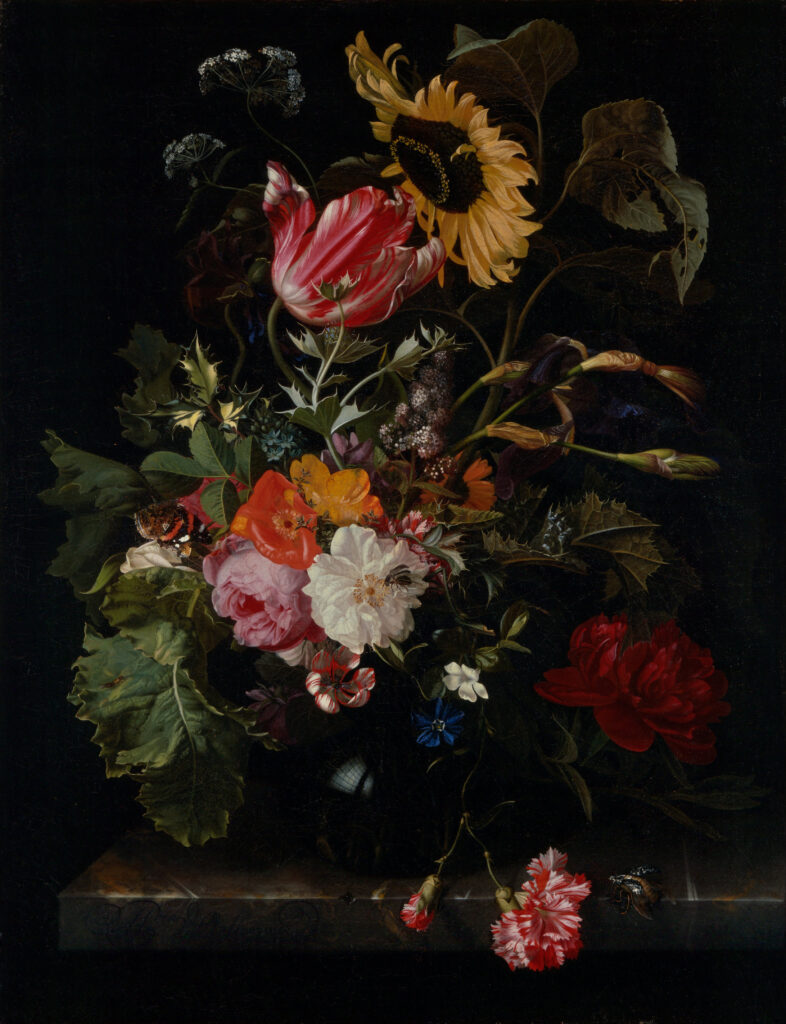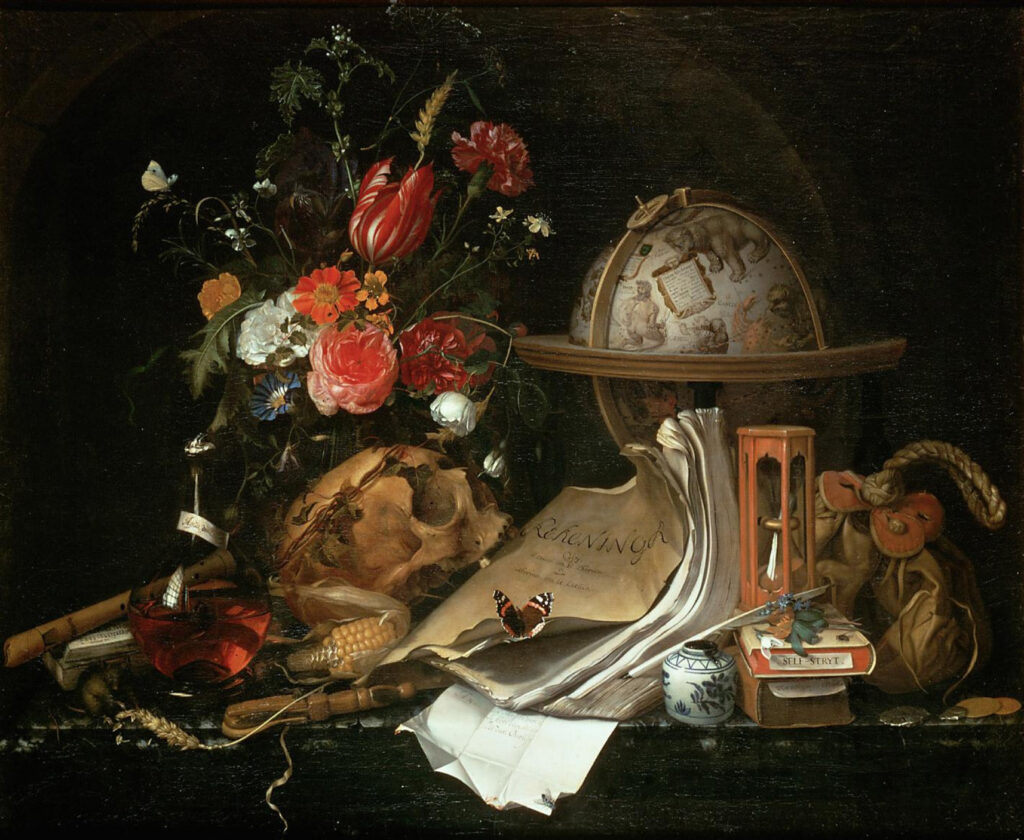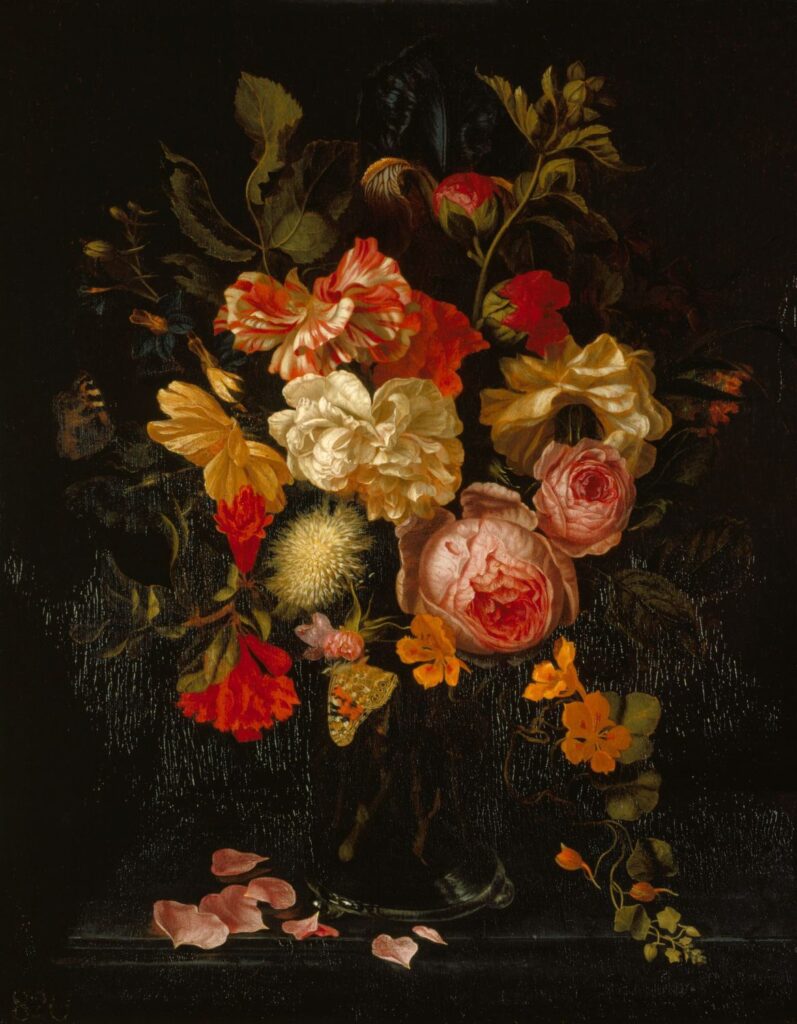René Magritte in 10 Paintings
René Magritte (1898–1965) stood at the heart of Surrealism, yet his art leaned toward a more figurative vision. He transformed ordinary objects...
Errika Gerakiti 21 November 2025
Maria van Oosterwijck was a talented but often overlooked artist of the Dutch Golden Age. She turned simple flowers into small stories about life, mortality, and hope, creating bouquets that dazzle with color and detail while hiding symbols that invite quiet reflection.
Maria van Oosterwijck (1630–1693) was born in Nootdorp, near Delft, and pursued her passion for painting despite societal barriers that prevented women from joining art schools or guilds. She trained with Jan Davidsz. de Heem, learning to paint detailed still lifes.
Her paintings show rich flower arrangements set against dark backgrounds and often include symbols like butterflies, skulls, hourglasses, and shells. These details, typical for vanitas art, reminded viewers of the fragility of life, the certainty of death, and the impermanence of worldly possessions. In her works, Van Oosterwijck successfully combined a profound spiritual message with the beauty of nature and meticulous detail.
Even though she was excluded from official artist guilds, Maria van Oosterwijck earned praise from some of Europe’s most powerful figures, including King Louis XIV of France and Emperor Leopold I. She chose not to marry and instead dedicated her life fully to painting. This was a bold act of freedom for a woman of her time.

Maria van Oosterwijck, Flowers in an Ornamental Vase, c. 1670–1675, Mauritshuis, The Hague, Netherlands.
This masterpiece is a striking example of Van Oosterwijck’s work, blending artistic precision with spiritual symbolism. Part of the Mauritshuis museum collection, it presents a lush bouquet arranged in an ornate vase adorned with putti and a goat, and a small statue of Venus. The flowers include rare species such as thyme, monkshood, and reed grass, while omitting the usual tulip.
At the top of the bouquet, a sunflower and opium poppy face one another—interpreted as metaphors for light and darkness, faith and forgetfulness. These opposing symbols, paired with lifelike insects and fading leaves, invoke the vanitas theme, reminding viewers of life’s transience. The controlled light, coming from the left, heightens contrasts and gives depth to the rich colors, while the meticulous brushwork brings the textures vividly to life. This composition showcases Van Oosterwijck’s technical brilliance and intellectual depth, offering a meditation on the beauty and fragility of life, faith, and mortality within a single, harmonious still life.

Maria van Oosterwijck, Roses and Butterfly, Crocker Art Museum, Sacramento, CA, USA.
Roses and Butterfly is a small but powerful example of Dutch still life. Likely painted between the 1660s and 1690s, it shows roses at various stages of bloom—some fresh, others beginning to wilt. A white, delicately painted butterfly sits on the biggest flower in the center. The composition is set against a dark background, a common technique that adds depth and enhances the vivid colors of the plants.
Dewdrops, soft petals, and sharp thorns are painted with great realism, revealing Van Oosterwijck’s refined technique and her sensitive command of light and shadow. While the rose often represents love and beauty, in the vanitas tradition, it also stands for life’s fragility and the passing of time. The butterfly, a familiar Christian symbol, refers to the soul’s transformation and resurrection. Together, these elements offer a quiet reflection on mortality and spiritual hope.

Maria van Oosterwijk, Bouquet of Flowers in a Vase, c. 1670s, Denver Art Museum, Denver, CO, USA.
During Maria van Oosterwijck’s era, the Dutch were fascinated by flowers, especially rare imports, which served as potent symbols of status and taste. However, their beauty came at a price: they were expensive and quickly faded. Flower paintings became a popular and enduring alternative, celebrated for showcasing God’s bounty and bringing the beauty of spring into homes year-round. Collectors especially prized variety in these floral arrangements.
Van Oosterwijck, a devoutly religious artist, often embedded deeper meanings within her intricately organized compositions. For instance, she used flowers, turning towards a sunflower to represent faithful souls looking to God. Furthermore, she included subtle yet significant details like insect-eaten leaves, a wilting rose, or a chipped stone ledge—each a poignant reminder of the transient nature of all earthly things.
The artist applied an exceptionally thin layer of paint, creating a smooth surface where brushstrokes are nearly invisible. This meticulous realism is evident in her precise rendering of light reflections, botanical details like leaf veins, and the inclusion of various insects—reflecting the 17th-century fascination with the natural world. Knowledgeable patrons highly valued such paintings, admiring both their beauty and scientific accuracy.

Maria van Oosterwijck, Vanitas Still Life, 1668, Kunsthistorisches Museum, Vienna, Austria.
Vanitas Still Life, held in the Kunsthistorisches Museum in Vienna, is a profound meditation on the fleeting nature of life and the vanity of worldly pursuits. At its center rests a human skull crowned with ivy, symbolizing death and eternal life. This is emphasized by carefully chosen surrounding objects: an hourglass marks the passage of time, an extinguished oil lamp evokes life’s fragility, and luxurious items—a silver jug, a bag of coins, and a globe—critique material wealth and human vanity.
In the center, the artist placed a book titled Reckoning (Rekeningh) and the inscription “We live to die, and die to live” (Wij leeven om te sterven en sterven om te leeven), reminding us that our deeds and debts will eventually be judged and settled.
In this work, however, Van Osterwijck subtly defies death. On a bottle marked aqua vitae (the water of life), she tucked a tiny self-portrait—a quiet signature ensuring that she will live on forever as an artist.

Maria van Oosterwijck, Still Life with Flowers and Butterflies, 1686, Royal Collection Trust, Kensington Palace, London, UK.
Still Life with Flowers and Butterflies, painted in 1686, features a glass vase on a ledge with different types of roses, an iris, and two butterflies. Fallen petals hint at mortality, reminding viewers that beauty fades, while the butterflies allude to Christ’s resurrection. By balancing both decay and renewal, Van Oosterwijck created not just a floral arrangement, but a reflection on life, death, and eternal hope.
P.S. Maria van Oosterwijck was one of the most talented women artists who specialized in floral still lifes. If you enjoy her paintings, be sure to check out our Flowers in Art postcard set, filled with amazing works by Van Gogh, Valadon, Ruysch, Manet, Cézanne, and many more!
DailyArt Magazine needs your support. Every contribution, however big or small, is very valuable for our future. Thanks to it, we will be able to sustain and grow the Magazine. Thank you for your help!